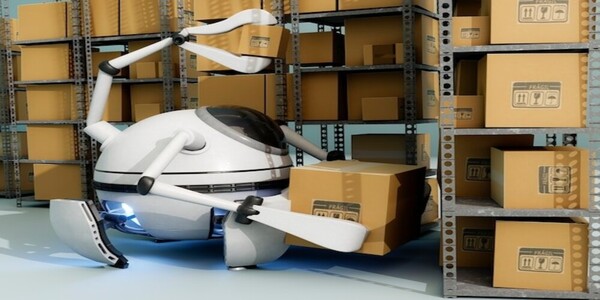
The logistics industry has been revolutionized in the past few years with new technologies such as Big Data solutions and artificial intelligence (AI). This emerging technology has given logistics professionals, students, researchers and academics an unprecedented insight into how increasing amounts of data can be used to analyze supply chain systems, improve inventory management strategies and generally optimize operations. In this blog post we will explore how these new advances on technology are impacting the field of logistics and unlocking potential for growth. We’ll also look at some case studies that demonstrate just how powerful these solutions can be – highlighting exactly why businesses may want to consider investing in them sooner rather than later.
Introducing Big Data Solutions and AI to Logistics

Logistics is an integral part of businesses of all sizes and across multiple industries. With the introduction of big data solutions and AI to logistic operations, companies can not only improve efficiency but also get real-time visibility into their business processes. By leveraging these technologies, businesses can automate routine tasks and increase accuracy in tracking goods and services as they move through routes. In addition, these technologies help to identify patterns in customer needs and preferences allowing for better planning and decision-making. Overall, the use of big data solutions and AI in logistics helps companies to optimize their processes and keep up with customers’ demands while remaining cost-effective.
Moreover, the integration of big data solutions and AI in logistics has led to the development of predictive maintenance, a technology that uses real-time data to predict equipment failure before it happens. This technology reduces equipment downtime, minimizes repair costs, and improves overall equipment effectiveness. With predictive maintenance, businesses can identify potential issues before they occur and take necessary measures to prevent them. As a result, businesses can avoid unexpected breakdowns, reduce repair time and costs, and ultimately improve their bottom line.
How Big Data Can Help Improve Warehouse Efficiency

Big data solutions have transformed the way warehouses operate by providing real-time insights into inventory management, order fulfillment, and operational efficiency. By analyzing vast amounts of data, warehouse managers can identify patterns and trends, optimize processes, and make data-driven decisions to improve efficiency.
One way big data solutions can help improve warehouse efficiency is by providing accurate demand forecasting. By analyzing historical sales data, seasonal trends, and customer behavior, big data solutions can provide accurate predictions of future demand. This allows warehouse managers to plan inventory levels accordingly, reducing overstocking or stockouts, and minimizing the associated costs.
Another way big data solutions can help is by optimizing warehouse layout and space utilization. By analyzing data on the movement of goods and people within the warehouse, big data solutions can identify bottlenecks and inefficiencies in the layout. This allows managers to reorganize the warehouse, reducing the time and distance traveled by workers and minimizing the risk of accidents.
Big data solutions can also help improve order fulfillment accuracy by tracking inventory levels in real-time. By providing real-time data on inventory levels and order status, warehouse managers can ensure that the right products are picked, packed, and shipped to customers on time. This reduces the likelihood of errors, improves customer satisfaction, and ultimately leads to increased sales.
The Benefits of Leveraging Machine Learning in Supply Chain Management

Big data solutions have transformed the supply chain industry by providing real-time insights into inventory management, order fulfillment, and operational efficiency. One of the most powerful tools within these solutions is machine learning, which uses algorithms to analyze data and identify patterns that help companies make informed decisions. Here are some of the benefits of leveraging machine learning in supply chain management:
- Improved demand forecasting: Machine learning algorithms can analyze large amounts of data to identify trends and patterns in consumer behavior, enabling companies to better forecast demand for their products. This helps companies optimize inventory levels and reduce the risk of stockouts or overstocking, leading to improved customer satisfaction and reduced costs.
- Increased efficiency: Machine learning algorithms can be used to optimize supply chain processes such as scheduling, routing, and inventory management. By analyzing data on delivery times, inventory levels, and other variables, algorithms can make recommendations to improve the efficiency of these processes, reducing lead times and lowering costs.
- Enhanced quality control: Machine learning algorithms can be used to analyze data from sensors and other sources to identify quality issues in real-time. This helps companies to quickly identify and resolve quality issues, reducing waste and improving customer satisfaction.
- Better supplier selection: Machine learning algorithms can be used to analyze data on supplier performance, including delivery times, quality, and pricing. This helps companies make informed decisions about which suppliers to work with, leading to improved relationships, lower costs, and better quality.
- Improved risk management: Machine learning algorithms can be used to analyze data on supply chain disruptions such as weather events or natural disasters. By identifying potential risks and predicting their impact, companies can take proactive steps to mitigate the impact of disruptions, reducing the risk of delays or product shortages.
The Positive Impact of AI on Delivery Operations

Big data solutions have revolutionized the delivery industry by providing real-time insights into logistics operations, inventory management, and order fulfillment. One of the most powerful tools within these solutions is artificial intelligence (AI), which uses algorithms to automate routine tasks and identify patterns in data to make informed decisions. Here are some of the positive impacts of AI on delivery operations:
- Improved route optimization: AI algorithms can analyze data on delivery locations, traffic patterns, and weather conditions to optimize delivery routes. This helps companies reduce delivery times and costs while increasing customer satisfaction.
- Increased accuracy in delivery tracking: AI algorithms can be used to track delivery vehicles and update customers on the status of their orders in real-time. This improves transparency and helps companies manage customer expectations, leading to higher levels of customer satisfaction.
- Reduced delivery errors: AI algorithms can be used to identify potential delivery errors before they occur. By analyzing data on delivery locations, order sizes, and delivery times, algorithms can flag potential errors and help drivers avoid them, reducing the risk of incorrect deliveries and the associated costs.
- Enhanced fraud detection: AI algorithms can be used to detect fraud in delivery operations. By analyzing data on delivery locations, payment methods, and other variables, algorithms can identify suspicious activity and flag it for further investigation, reducing the risk of financial losses.
- Improved safety and security: AI algorithms can be used to monitor delivery vehicles and detect safety or security issues in real-time. This helps companies respond quickly to incidents and reduce the risk of accidents, theft, or other security breaches.
In conclusion, AI is a powerful tool within big data solutions that can help companies optimize their delivery operations, improve customer satisfaction, and reduce costs.
Exploring the Possible Downsides to Using Big Data Solutions in Logistics

While big data solutions have many benefits for logistics operations, there are also some potential downsides that companies should be aware of. Here are some of the possible downsides to using big data solutions in logistics:
- Data privacy concerns: Big data solutions rely on the collection and analysis of large amounts of data, which can raise concerns about privacy and data protection. Companies need to ensure that they are complying with data protection regulations and taking steps to safeguard customer data.
- Overreliance on technology: While big data solutions can provide valuable insights and automate routine tasks, companies need to ensure that they do not become over-reliant on technology. It is important to maintain a balance between technology and human expertise to ensure that companies are making informed decisions and managing risks effectively.
- Cost: Implementing big data solutions can be expensive, and some companies may struggle to justify the cost of investing in new technology. It is important to carefully evaluate the potential benefits and weigh them against the cost of implementation.
- Complexity: Big data solutions can be complex and require specialized skills and expertise to implement and manage effectively. Companies may need to invest in training or hiring new staff to ensure that they are able to leverage the full potential of these solutions.
- Potential for errors: While big data solutions can provide valuable insights and automate routine tasks, there is still the potential for errors in data collection or analysis.
In conclusion, while big data solutions offer many benefits for logistics operations, there are also some potential downsides that companies need to be aware of. It is important to carefully evaluate the potential risks and benefits of these solutions and ensure that they are implemented and managed effectively to maximize their impact on the business.
Where Are We Headed with Logistics and AI in the Future?

The logistics industry is constantly evolving, and the use of artificial intelligence (AI) is expected to play a significant role in its future. Here are some potential developments we may see in the coming years:
- Increased automation: As AI technology advances, we may see more automation in logistics operations. This could include the use of autonomous vehicles and drones for delivery, as well as robots for warehouse operations.
- Greater use of predictive analytics: AI-powered predictive analytics can help logistics companies anticipate demand, identify potential supply chain disruptions, and optimize routes for maximum efficiency. As these technologies continue to improve, we may see more widespread adoption of predictive analytics in logistics.
- Improved customer experience: AI can help logistics companies provide a better customer experience by enabling real-time tracking, personalized recommendations, and faster delivery times. As companies look to differentiate themselves in a competitive market, we may see greater investment in AI-powered customer experience solutions.
- Enhanced sustainability: AI can help logistics companies reduce their environmental impact by optimizing delivery routes, reducing waste, and improving energy efficiency. As sustainability becomes an increasingly important consideration for consumers and businesses, we may see greater adoption of AI-powered sustainability solutions.
- Collaboration and innovation: As AI becomes more prevalent in logistics, we may see greater collaboration and innovation between logistics companies, technology providers, and other stakeholders. This could lead to new business models, partnerships, and solutions that drive innovation and growth in the industry.
In conclusion, the future of logistics and AI is likely to be characterized by greater automation, improved predictive analytics, enhanced customer experience, increased sustainability, and greater collaboration and innovation. As these technologies continue to evolve, it will be important for logistics companies to stay ahead of the curve and leverage AI to remain competitive and meet the evolving needs of customers and stakeholders.
In Conclusion
Big data solutions and AI can have a significant impact on the logistics sector, increasing operational efficiency, enhancing the customer experience and allowing for more informed decision-making. With their ability to monitor and analyse key metrics, they are becoming increasingly popular within the industry. Although there are potential downsides to using big data solutions in logistics, such as privacy concerns and misinterpretation of data analysis results, these risks can be managed through careful selection, implementation and monitoring processes. Looking to the future, big data solutions and AI are likely to play an even bigger role in logistics operations, particularly when it comes to improving safety standards, reducing emissions, introducing new services and lowering costs.


